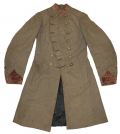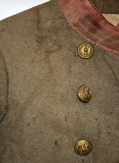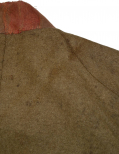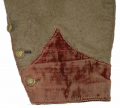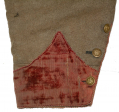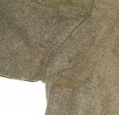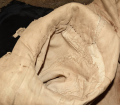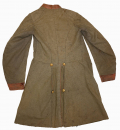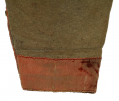site search
online catalog
CONFEDERATE OFFICER’S COAT OF CAPT. WILLIAM J. REESE, JEFF DAVIS ARTILLERY: BATTERY COMMANDER JANUARY 1863 - MAY 1864; WOUNDED BEALETON STATION; IN COMMAND AT CHANCELLORSVILLE, GETTYSBURG, SPOTTSYLVANIA; CAPTURED AT THE “BLOODY ANGLE”

$50,000.00 SOLD
Quantity Available: None
Item Code: 1179-243
Formerly in the collections of the Texas Civil War Museum, this is a great looking Confederate artillery officer’s frock coat belonging to Captain William James Reese (1829-1897,) who served as a lieutenant and then captain of the “Jeff Davis Artillery,” and showing period repairs from his wound at Bealeton in October 1863, making it very likely it was not only his coat earlier at Gettysburg, but also when his guns were overrun in hand-to-hand fighting at the Bloody Angle at Spotsylvania in 1864. The coat is accompanied by a large research file and conservation reports.
Born in Autauga County, AL, in 1829, Reese was from something of a medical family. Older brother Walter P. Reese was a prominent physician in Selma and William settled into a career as a dentist in the early 1850s after a brief taste of military life in the Mexican War. Although just “a schoolboy,” he joined Captain Irby’s Company B of Seibel’s Battalion of Alabama Volunteers, enlisting at Mobile on 12/24/47 and serving for six months under Bankhead at Vera Cruz and the towns of Orizaba and Cordoba. The unit returned home in June 1848 for muster out with Reese discharged at Mobile 7/3/1848. He took up dentistry after his return home, opening a practice at Montgomery, where he enlisted on 7/27/61 and mustered in as a 2nd Lieutenant in Capt. J.T. Montgomery’s Company, Light Artillery, Alabama Volunteers, the “Jeff Davis Artillery.” He is mentioned both in articles about the unit published in the Confederate veteran by J.P. Purifoy, Purifoy’s unpublished history of the unit and Laboda’s more recent effort, “From Selma to Appomattox.” Some of Reese’s letters are quoted by Laboda and the research file includes some photocopies of the originals.
Reese had a realistic view of the financial cost of raising a battery of light artillery and the human cost of the war to come, having written his brother in May 1861 that he expected a “long and bloody war.” The battery moved in August to join Confederate forces at Manassas and Centreville, Virginia, where they had established camps and fortifications after First Bull Run. He was left sick along the way, at Lagrange on August 24, but rejoined the company not long after: he is listed as present on the muster roll covering Aug. 31 to Oct. 31 and in November wrote from their Virginia camp to his future wife, sister of a fellow officer, that the battery occupied, “one of the most advanced positions in our field works.” His first term of service with the battery ended early in 1862: he resigned in January along with all the other lieutenants of the battery in protest at the reinstatement of Capt. Montgomery after he had been dismissed from the service by a courtmartial. Reese’s January 8 letter pulled few punches: “Capt. J.T. Montgomery is a person for whom I have no respect either as gentleman or an officer.”
The Confederate high command solved the problem by promoting Montgomery out of the battery soon after, but the vacancies resulted in several changes of command until J.W. Bondourant, a former sergeant, was promoted to lieutenant and then captain, restoring some esprit-de-corps and gaining praise for the battery’s performance on the Peninsula, South Mountain, Antietam, and Fredericksburg. Reese returned shortly after the latter battle apparently having been designated to replace Bondourant, who was to be promoted to D.H. Hill’s Chief of Artillery in the reorganization of the army’s artillery in Spring 1863. Reese’s widow believed he had served with Forrest during the intervening year. Purifoy could not confirm it, but a card in Reese’s CMSR file indicates he had been a sergeant in Co. H 51st Alabama Partisan Cavalry, organized in August 1862, and was discharged to date March 4, 1863, presumably because he was, “app. a Comd. Officer” (appointed a commissioned officer,) but he does not appear on their muster rolls. Laboda says that he had been elected lieutenant (again) in the battery while still with the cavalry unit, reached the battery by February and immediately took over command while both he and Bondourant waited for their promotions to come through. The March 4 discharge date from the cavalry was certainly an after-the-fact bit of bookkeeping. Reese writes to his future wife on March 2, 1863, saying that he had been, “kindly received by my old command.” According to Laboda, Reese took command of the battery unofficially on Feb. 28 though he had not “formally taken over the captaincy of the battery” until May 8, but was commanding it earlier, including at Chancellorsville. This may be the date on his commission, the effective date of rank, or the date he received it, but we find him still listed as fist lieutenant on the roll up to April 30 and captain on the consolidated muster roll covering April 30 to June 30, 1863.
In any case, Reese’s first fight as battery commander was during the Chancellorsville campaign. On April 30 his guns were in action along the Rappahannock, dueling with federal guns on the other side of the river at Fredericksburg, firing 72 rounds and escaping loss, Reese writing that many enemy rounds, “passed over our heads and burst all round us without doing any harm.” The battery then marched to confront Hooker upriver at Chancellorsville and was in the van of Jackson’s flank march. Reese recalled, “the day was oppressively hot and many fell on the roadside from exhaustion. Gen Jackson rode up and down the column telling ‘the boys’ that every moment was a fortune and they rushed forward throwing away blankets, knapsacks everything but their guns and ammunition. I blessed my stars I had a horse to ride…” The attack was mainly by infantry, but the battery did come under Union artillery fire, losing 5 men, 9 horses, and 3 caissons. On May 3 they were more heavily engaged in driving Union artillery back from Fairview, firing 305 rounds. Reese was the only commissioned officer with the battery and noted, “our position was in the center and at one time was a very hot place. . .The firing was terrific and caused the blood to gush from the nose of one of my gunners, and most of the cannoneers were deaf when they came out of the fight. I had my horse tied to a small tree which was shot off above his head by a cannonball . . .”
In the Gettysburg campaign, as part of Carter’s artillery battalion in Ewell’s Corps, leading Lee’s advance, the battery took part in the fighting at Berryville and Martinsburg, where on June 14 they engaged a Union artillery battery, and in the capture of the town were able to uniformly rearm themselves with four Union 3-inch rifles and their caissons. On July 1 they were in the advance as Ewell approached Gettysburg from the north and were deployed near Oak Hill, supporting Rodes’s ill-coordinated attacks, but enfilading the lines of the Union 11th Corps and materially aiding in the collapse of the Union lines. July 2 was relatively quiet for them. Ewell left Carter’s battalion out of his attacks on Culp’s Hill. They were redeployed to a position near the railroad cut, however, to take part in the bombardment of Union lines in preparation for Pickett’s Charge on July 3, apparently taking Union 11th Corps positions on Cemetery Hill as their target. Reese’s 1897 obituary asserts the battery succeeded in silencing a group of nineteen Union guns, likely something of an overstatement, but indicating they were in action. Their ammunition expenditure was 229 rounds during the three days. Most of the battery’s losses in the campaign, however, were in Lee’s retreat, when Union cavalry destroyed much of Ewell’s supply train near Monterrey, costing the battery its forge, supply wagons, and 8 men captured.
The battery skirmished with Union pursuers and was in action at Falling Waters and other fights before the close of the campaign, and then was active again in the Fall as Lee moved north around Meade’s right flank, skirmishing with the Union rearguard at Auburn and Warrenton Springs. In the back and forth fighting on the Rappahannock, however, Reese was wounded at Bealeton Station, just north of Rappahannock Station, on October 26 in a fight with Union cavalry and elements of the 3rd Corps. A shell or case-shot burst overhead slightly wounded one of his men but a fragment or ball inflicted a wounded Reese more seriously in the right shoulder- something borne out by the records and by Reese’s coat itself, which shows repairs in that location and evidence of blood stains that were partially cleaned, indicating he continued to wear the coat in service. Hospital records show him admitted to Gen. Hospital No. 4 in Richmond for a gunshot wound in the right shoulder on Oct. 31 and returned to duty on Dec. 1. He likely received a furlough home to recover further. Laboda says he returned to the battery on Jan. 13, 1864.
Reese’s last action with the battery, and its last service as a unit, was at Spotsylvania. They had arrived early in Lee’s move to head off Grant’s march after the Wilderness and were posted in salient. With the other artillery they were withdrawn in expectation of a continued march by Grant and only deployed again shortly before Hancock’s massive assault hit the “mule shoe” and “bloody angle.” Reese’s guns were positioned by section. He was with the left section when the assault struck. One of his gunners, holding a lanyard already hooked into a friction primer on the gun, recalled, “I could have touched Captain Reese with my left hand. you could not distinguish a man ten paces from you. The first thing I knew the enemy’s line of battle was coming over the temporary works at my gun, and one slapping his hand on the gun opposite me, said, “Surrender.” The gunner escaped in the chaos, but Reese did not. Three of the battery’s four guns were captured, twenty-two of its horses killed and about forty men, roughly half the battery, including Reese and his lieutenant, were killed, wounded or captured. They had still managed to get off 20 or 25 rounds in the fighting, most probably fired by the two guns of the right section. The one remaining gun and crew were attached to another battery for the rest of the war. Reese was sent to Belle Plain with other prisoners and eventually imprisoned at Fort Delaware. He took the oath of allegiance at the end of the war and was released June 16, 1865.
Reese returned to Alabama after his release, but spent some time in Galveston, Texas, perhaps considering emigrating further south: he mentions the attractions of Brazil in a postwar letter, but seems to have been back in Montgomery by late 1866 when he married Margaret Walker, sister of Lieutenant Robert Walker, a member of the battery who had resigned alongside Reese in January 1862. He resumed the practice of dentistry in Montgomery, apparently retiring to his plantation in June 1887 for health reasons. He died there Aug. 9, 1897.
Reese’s coat is accompanied by a 2008 conservation report by Historic Textiles Studio of New Bern, NC. The report not only details their conservation and repair work, but earlier repairs as well. This includes some circa 1900 work, but also Civil War period repairs to the right shoulder, an area where there is also evidence of bloodstains, all fitting with Reese’s 1863 wounding at Bealeton. The coat shows as a muted butternut color from the original gray dye shifting slightly, and is trimmed in red on the collar and cuffs, with red cording down the lapel, and signs there had been similar cording on the vents and skirts. The buttons had been long-ago removed, likely by the family as mementoes, and replaced by a collector with some excavated a CS artillery-A buttons. These were appropriately replaced in the conservation process by 14 original non-dug Confederate “droop wing” eagle buttons in two rows on the chest, four more on the rear waist and skirts, and three simple small US staff buttons on each cuff. The report indicates the collar had a single brass bullion wire rank bar on each side when received, but showed signs of two. This was replaced with three on each side as appropriate for display in the museum.
The full conservation and treatment report can be reviewed by interested parties. This is an exceptional coat worn by an officer with active service in some major engagements, including Gettysburg, and who was wounded in action. There is plenty of work to be done in fleshing out his battle history and his personal history as well. Letters partially quoted in the battery history or included as photocopies in the research file show him to have been a literate and observant correspondent. Even our brief survey uncovered interesting details of internal army affairs and politics as well as the difficulties faced by artillery as a branch of service in the Confederate army. We also suspect there is some interesting information out there on Reese’s service with Forrest and his ability to gain a second officer’s commission and posting with his old unit in early 1863. [sr] [ph:L]
~~~~~~~~~~~~~~~~~~~~~~~~~~~~~~~~~~~
THIS ITEM, AS WITH ALL OTHER ITEMS AVAILABLE ON OUR WEB SITE,
MAY BE PURCHASED THROUGH OUR LAYAWAY PROGRAM.
CLICK HERE FOR OUR POLICIES AND TERMS.
THANK YOU!
Inquire About CONFEDERATE OFFICER’S COAT OF CAPT. WILLIAM J. REESE, JEFF DAVIS ARTILLERY: BATTERY COMMANDER JANUARY 1863 - MAY 1864; WOUNDED BEALETON STATION; IN COMMAND AT CHANCELLORSVILLE, GETTYSBURG, SPOTTSYLVANIA; CAPTURED AT THE “BLOODY ANGLE”
For inquiries, please email us at [email protected]
Most Popular
Historical Firearms Stolen From The National Civil War Museum In Harrisburg, Pa »
Theft From Gravesite Of Gen. John Reynolds »
Selection Of Unframed Prints By Don Troiani »
Fine Condition Brass Infantry Bugle Insignia »
Wonderful Condition Original Confederate-Manufactured Kepi For A Drummer Boy Or Child »
featured item
UNIQUE "CSA" ENGRAVED BELT PLATE
This belt plate is of the clipped corner "Militia" type dating circa 1835 to 1850 (see Kerksis' Plates and Buckles of the American Military 1795-1874 Figure 183). It is made of heavy gauge stamped sheet brass and is slightly contoured. It has 3 brass… (88-206). Learn More »
site search
Upcoming Events
Closing at 1pm on Monday, Dec. 30th; closed Dec. 31st and Jan 1st for New Year's. The shop is… Learn More »



